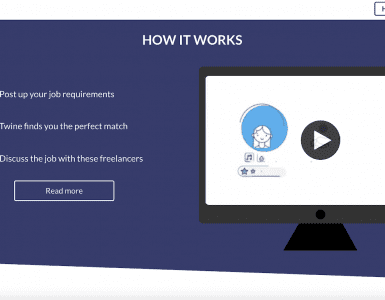Are you looking to hire a creative freelancer? Visit our freelance marketplace to post up a job and top quality freelancers will contact you with their rates.
One important aspect of working with a freelancer that often gets overlooked is how you’re going to pay them. Not how much, or when, but the actual method you use to transfer funds to your freelancer. There are lots of ways to transfer money these days, some more complicated than others. So you should discuss and agree on a payment method with your freelancer before you start working together.


‘But, money is money right? What does it matter how they get paid as long as they do?’ I hear you ask. Well, this all depends on where your freelancer is located. Some services aren’t available in certain countries, or charge a horrendous fee for transferring money. So there’s no point planning to pay your freelancer via PayPal if it’s not actually available in their country. Your freelancer won’t get their payment on time, which could have disastrous consequences for them. And what’s more, you’ll come out of it looking disorganised.
Here’s our run-down of the top payment methods you can use. And, no – cash in hand is not an acceptable option! We’re watching you…
-
PayPal:


PayPal is almost a household name across the globe now. They let you send and receive money quickly and safely. You can pay anyone whether they’re a business, individual or charity. All you do is enter their PayPal details, the amount you want to pay and you’re away. Rather simple, really.
But, beware – PayPal isn’t available in all countries so check with your freelancer beforehand. PayPal is free for non-commercial use. But they charge a small fee for sending money internationally, paying in a different currency or if the payment is funded with a credit card. It’s best to check this in advance. The freelancer could also be charged a fee when they come to withdraw their money from their PayPal account.
-
Bank transfer:


You can always rely on the trusty bank transfer to send money. There’s no third party fees and you know exactly who you’re dealing with
However, this method can be slow, especially when you’re sending money internationally. Make sure your freelancer is aware that there’ll be a delay. Check with your bank to see how long the payment will take.
There can be fees involved for sending money internationally too. Check with your bank for more information.
3. Freelance service:


If you’ve hired your freelancer through a reputable freelance marketplace, they often have ways and means for you to pay through the platform. Upwork, Freelancer and People Per Hour are all examples of sites where you can hire freelancers and pay through the website. And our very own Twine of course. If you have this option, it’s best to take it. It’s often quicker and less hassle for you to send payment through your chosen service. Plus, they provide extra safeguards in case a dispute arises between you and your freelancer. You probably won’t need those services, but it’s good to know they’re there.
They may charge a fee, but this is dependent on the individual service, so check in advance
4. Payoneer:


Payoneer is an international money transfer service, similar to PayPal. It’s very popular with freelancers, so you might find that your freelancer requests to use this service.
Payoneer was set up to make international payments easy, which is probably why it’s gaining popularity in the freelance world. On first glance it’s slightly more complicated than PayPal. They offer a number of products and services, not unlike a real bank, including a Payoneer MasterCard that you can use just like a regular credit card.
Another reason why they’re so popular – they have extremely low fees. Just 1%. And, if both of you have Payoneer accounts, then you can send and receive money for free. That’s a real bonus.
5. Skrill:


Skrill is another online payment service, like PayPal and Payoneer. As with Payoneer, their fees for sending money are only 1%. What’s more, this fee is capped at a max of $10. Which really makes a difference if you’re making lots of online transactions. At the end of the day, that’s more money in your bank account. The good news for your freelancer is that it’s always free to receive money.
Just like Payoneer, Skrill also offers a pre-paid MasterCard that you can use just like any other regular debit card in shops or at ATMs.
There are fees involved in setting up an account, and they depend on what country you’re based in. So, best to check before hand. You can check their fees here. There’s a lot of anecdotal evidence on the internet about Skrill being difficult to set up an account with (lots of slow verification and identity checks) and being somewhat lacking in the customer service department. However, as always it’s best to check these facts and do your own research.
6. Western Union:


Western Union is a global money transfer service. You might be more familiar with their yellow-fronted shop windows dotted along most major high streets, but they operate in an online capacity too.
Western Union allows you to send money to anywhere in the world. So no good if you’re sending money within your own country.
Western Union will charge a fee to send money. This is entirely dependent on the country you’re based in and the country you’re sending money to. For an idea of what you’ll be dealing with, their fees start from $5, but are capped at $10. You can choose to send money to a bank account, or have the recipient pick it up in cash at one of Western Union’s many outlets.
As previously mentioned, they do have physical premises that you can go to. So if you’re not confident with online stuff, you could find your nearest branch and get a real person to help talk you through the process.
7. Cash:


If you’re working with your freelancer in person and the project is small, there’s no reason why you can’t pay your freelancer in cash. Make sure you get your freelancer to give you a valid invoice for tax purposes if you’re going down this route.
It’s not the most convenient option for your freelancer. They’ll have to go to their bank to deposit the cash into their account, which could be time consuming for them. Don’t consider cash if your project is large or for ongoing payments.
8. Cheque:


In the US, it’s still common for a lot of clients to pay their freelancers by cheque. Technically, there’s nothing wrong with doing this. But be aware that this is a slow method of payment for the freelancer and can be a pain for them.
Instead of receiving the money instantly, like with an online transfer, they have to wait for the cheque to arrive in the post, physically go to their bank to cash it, then wait for the money to transfer to their account. This whole process could take over a week. Also, you can’t pay international clients with a cheque, so no good for sending money abroad.
To find a creative for your next project, click here







